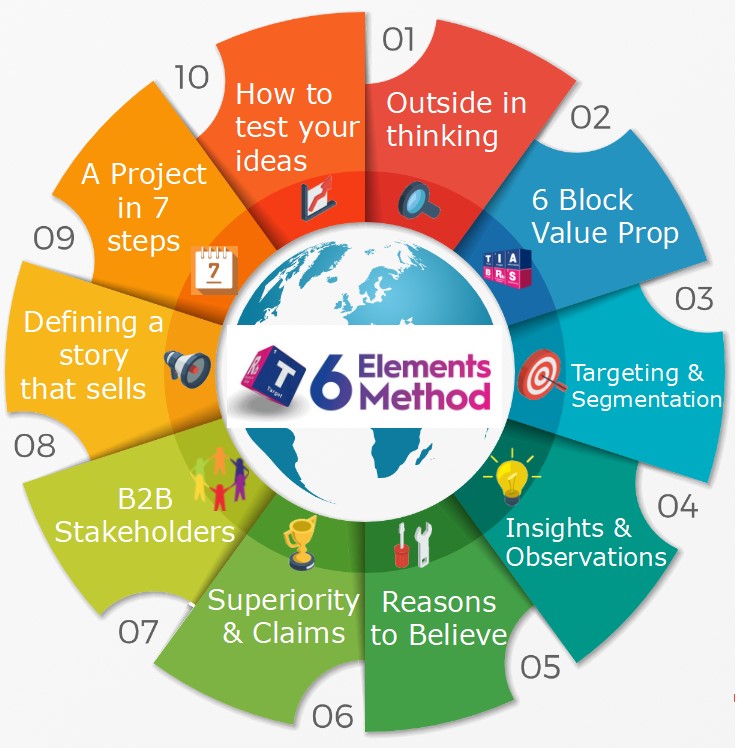Click on each coloured segment of the wheel to find out more

Outside In™ are global experts in creating and teaching the competency of Insight and Value Proposition creation for large complex companies. Our success is reflected in the fact that everyday our tools and thinking are used by over 250,000 employees around the world.
Because we specialise in just this one topic, our expertise has been sought in the boardrooms of global multinationals. Our clients have revenues of over $160 Billion and spend $16 Billion on R&D and Innovation each year.
We have delivered projects over 10 years and trained 35,000 people in 27 countries across a diverse range of B2B, B2C, Service and Product companies. Teams have joined us from blue chip companies like Philips, Samsung, Schneider Electric, GSK, Unilever, Lafarge, Electrolux, P&G, Bank of America and Pepsi. We have also been asked to train smaller organisations and incubators, start ups and University faculties. Maybe we have trained you in the past or maybe you are part of a new team who have yet to experience our training?
The profile of trainees for Outside In’s session normally comprise of a mix of upstream and downstream marketing and sales folks, product management, market research professionals, senior business heads, business group managers, product managers and R&D (Product Engineers and Developers). Training is delivered to teams and groups meaning we have no individual enrolment courses and the training can be delivered both face to face or virtually.
Our Training course on Value Proposition creation has been designed for teams rather than individual enrolment and the agenda of the sessions consist of 10 modules. You can learn about each module of the agenda by clicking on the relevant segment of the wheel above.
Outside In Thinking


This session explains the essential overview of how moving from a technology push culture to an insight driven approach is beneficial for high tech companies. The module covers:
- Numerous examples and case studies to demonstrate best practice.
- Sets a clear vision for participants as to the value of this way forward for their company.
- Explains clearly how the Value Propositions and Insights fit together to create better solutions.
- Demonstrates why this is relevant to them whether they are in R&D, Sales, Marketing or Senior Management.
- Explains how this fits seemlessly with other existing innovation processes
6 Block Value Prop


This session explains the 6 Block thinking framework that has been used globally to teach 35,000 people to write better Value Propositions. The module covers:
- The role of each of the 6 elements.
- The sequence of logic flowing through each choice in the thinking framework.
- The common mistakes and traps to avoid.
- How Value Propositions can cascade to deliver a business group, solution, or product line story.
- Great examples of 6 Block Value Proposition that grew the business.
Targeting & Segmentation


This session explains how Targeting and Segmentation form the first critical choice in any innovation project. This module covers:
- The difference between a target and a business case (why targeting everyone is false economy).
- How to define the available market (Porters 5 forces).
- The 4 key types of Segmentation, (Behavioural, Demographic, Attitudinal and Geographic) and how to combine them.
- How Segmentation works in B2B markets.
- The possibilities created by having multiple targets and multiple Value Propositions for the same solution.
Insights & Observations


This session explains what Insights are (and what they are not). It covers the myths surrounding insights and digs deeper into how to create a competitive understanding of the customer in real life examples. This module covers:
- The difference between data and insights and why that matters.
- What are Accepted Customer Beliefs and how to we deal and overcome such unhelpful beliefs.
- What are Industry Perpetuated Myths and how to avoid the traps of creating them yourself.
- How to find better Insights (5 Why’s approach). How to interview customers and consumers in a different way to discover unmet needs.
- How to synthesise your findings into insights and capture them in writing.
Reasons to Believe


This session explains why it’s OK to focus on your technology, but only as an enabler to the benefit and not as the point of the exercise. This module covers:
- The difference between Specifications and Features.
- How to ladder up specifications to more meaningful support for your benefit.
- Endorsements, Testimonials, Awards, Statistics, Test results and Brand heritage- How RTB’s can be more than just technology.
- The difference between hygiene factors (standard requirements and RTB’s).
- Ranking RTB’s – Kano Analysis.
Superiority & Claims


This session explains why it’s vital for your solution to have a point of differentiation over all the alternatives. This module covers:
- The difference between running a Value Proposition and a ‘Me too!’ project.
- How the Alternatives, RTB’s and Benefits of your solution interact to drive the Superiority.
- Why Value Propositions need to be consistent over time and Superiority is key to strategic success and creating long term technology roadmaps.
- 10 ways to claims Superiority including Self Referencing, Top parity, Uniqueness and Statistical Superiority.
B2B Stakeholders


This session explains how Value Propositions and Insights work in a B2B environment where there is a complex stakeholder chain including differing opinions and priorities. The module covers:
- Selecting the Key Stakeholder to establish the Pain Point for your insight.
- The interaction between purchase decision makers, payers, specifiers, installers, users and consumers.
- Using the Value Chain tool to communicate the value of your solution to each stakeholder in the most compelling way.
- The Red Thread. Creating single minded Value Propositions that are relevant to all stakeholders.
Defining a Story That Sells


This session explains how complex stories and over engineered Value Propositions lose customer interest. It demonstrates the advantage of clear single minded communication focused around a clear well articulated benefit. The module covers:
- Maslow’s Hierarchy of Needs, how communicating the benefit of technology needs to be less rational and more emotional.
- How Value Propositions work when created globally, then rolled out and activated locally.
- How to create consistent Marcomm and Sales Stories that work.
- Practical tools to help to articulate the benefit including ‘emotional laddering’ and the ‘So What Test!’
A Project in 7 Steps


This session explains how to actually run a Value Proposition Project from beginning to end. It talks the team through defining the brief and objectives of the project and the key milestones and workshops needed so it is most likely to succeed. The module covers:
- The difference between Disruptive, Incremental and Positioning Projects and why that matters when creating a project.
- Step by step guide to the 7 steps of a project, from the brief at the Kick Off meeting through to Insight Synthesis and Value Prop Workshops.
- Case studies of each kind of project including clear guidance on how to adapt the project to fit timings, objectives and budgets.
- Tools, templates, workshop agendas, meeting invites and timelines for your chosen project.
How to Test Your Ideas


This session explains how to question your target customer and interview them in a way that will most effectively gain deeper insights. It also cover market research methodologies for observing their workflows and for validating your solutions. This module covers:
- Insight Generation techniques, open questioning and avoiding bias in your interviews.
- Structuring and interview and tangible interview questionnaires for different types of innovation project.
- Validating your Insights and Value Props, qualitatively and quantitatively..
- 15 Methods to observe and understand your target better than your competitors do.
- Online quantitative studies, building, recruiting and interpreting them.
